The Ficus Bonsai tree starts smart, but grows easily! Because it’s the first choice for beginner bonsai lovers. Best beginner bonsai ever, dwarf trees like Ficus, Jade, Chinese Elm, Schefflera, and Juniper that are perfect for new bonsai lovers. Those are the easiest bonsais for both indoor and outdoor use.
Bonsai is a traditional living art of spirituality. Japanese Maple and Pine Bonsai can feel tricky at first but don’t worry. They grow slowly, stay small, and are easy to care for in daily life. That’s what bonsai is all about: miniaturization, or keeping a tiny plant full of life.
Bonsai began in Japan, but it started even earlier in China as penjing and in Japanese Zen gardening. The goal is to shape a small tree to look old and wise, using the best bonsai tools like pruning scissors and wiring. You place it in a shallow bonsai pot and care for it with time and patience.
It also teaches you a special feeling called wabi-sabi, a love for simple, quiet beauty. If you’re just starting, a bonsai starter kit can make things easier. However, when you choose is yours for the right tree and show you how to grow it with joy.
What Is Bonsai? Why is The Best Bonsai Tree For Beginners So Special?
Bonsai is not just a dwarf plant in a pot. Bonsai is a traditional living art. The Japanese word bonsai means “tree in a shallow pot”. But it didn’t start in Japanese Zen Buddhism. It first began in China, where it was called penjing, and later in Vietnam as hòn non bộ. These old traditions taught people how to shape tiny trees to look like real ones found in spiritual healing and connection with nature.
When you care for and grow a bonsai plant like a family, your goal is miniaturization. That means keeping the tree miniature, but still full of life and beauty. You use careful pruning and gentle wiring to shape the branches. The tree sits in a bonsai pot, a shallow container that helps control its size.
But bonsai is more than just trimming and training. It’s about wabi-sabi, a feeling of peace and calm, and finding beauty in simple things. As you care for your dwarf tree, you’ll learn patience, focus, and how to enjoy peaceful moments. That’s what makes bonsai so special, inner peace for beginner bonsai lovers’ home corners.
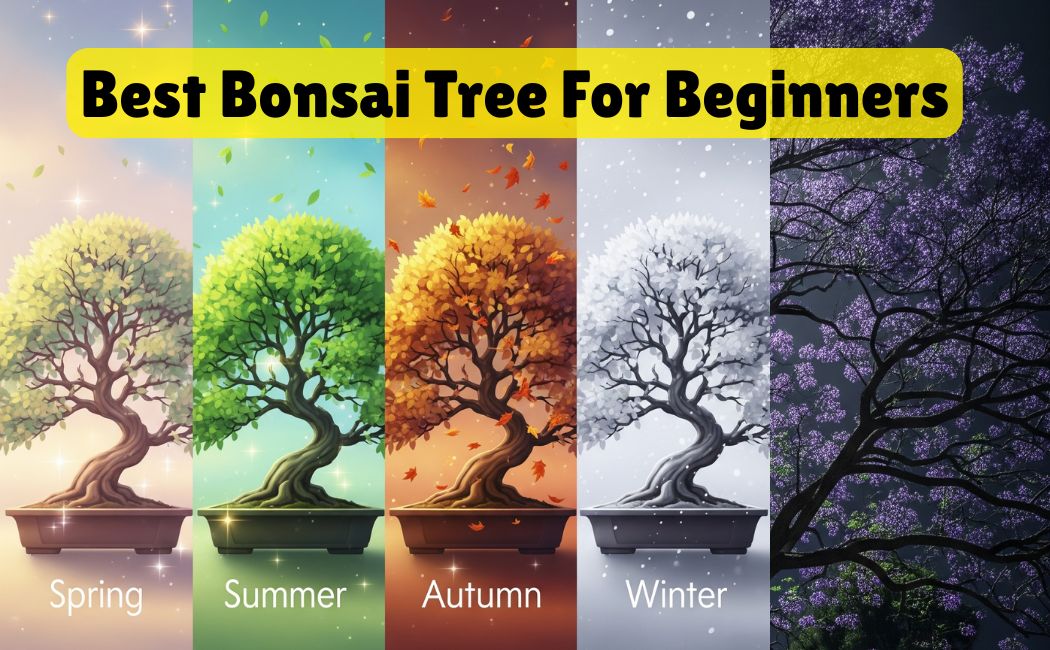
9 Best Bonsai Trees for Beginners Can Start Smartly.
Most bonsai plant lovers’ first question is “Which bonsai tree is best for home beginners, an easy start?” Not all bonsai trees are easy to care for, especially if you’re new. But some types are perfect for beginners like you.
They don’t need much water, grow slowly, and can live indoors or outside. Below are nine of the best bonsai trees to start with. These are easy to shape, strong, and great for learning. Confused about Bonsai? Here are the best beginner dwarf plants to start with;
1. Ficus Bonsai: Strong and Easy Indoors
If you want a bonsai that’s hard to kill, go with a Ficus bonsai. Other species, Ficus retusa, and Ficus ginseng, are also the most popular trees for beginner bonsai lovers. The Ficus bonsai is an ideal dwarf plant for best bonsai trees for beginners who are new to do not have the time for regular watering.
A top pick for beginners. Ficus is a hardy tropical tree that grows well indoors or outside in warm places, even if you don’t have bright sunlight. Ficus trees have thick trunks and shiny green leaves. They can handle small mistakes like overwatering or missed pruning.
Best beginner bonsai ever for you if:
- When you live in an apartment or rent a house balcony
- You want a tree that grows indoors
- Need you’re still learning to trim and water correctly
Since the ficus is so resilient to underwatering, it makes it ideal for those who want a low-maintenance tree.
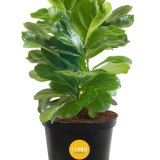
Getting an Exclusive Product on Amazon;
Costa Farms Little Fiddle Leaf Fig, Live Indoor Ficus Lyrata Plant in Nursery Plant Pot, Houseplant in Potting Soil, Housewarming, Birthday Gift, Office, Home, and Room Decor, 1 Foot Tall.
2. Jade Bonsai: Low Water, Big Charm
Jade Bonsai (Portulacaria afra) is not just a dwarf plant, but also a succulent, which means it stores water in its leaves. That makes it a perfect bonsai if you forget to water sometimes. It has round, shiny leaves and a thick trunk. It also grows slowly, so you won’t have to prune too much.
Best beginner bonsai ever for you if:
- Most of the time, moving out of the house, job, or service, traveling,
- You want a bonsai that doesn’t need daily care
- When living in cold areas, you like cute, tiny trees, and they can be grown outdoors in full sun and high temperatures.
- You’re living in the Arizona desert or near Texas Hot. The Jade is considered an indoor tree in most temperate zones.
- Jade loves sunny windows and grows slowly, so it doesn’t need much trimming.
- Low water needs, grows indoors, and cute, chunky look.
Jade Bonsai Tree Symbolism: Abundance. Also known as the money tree, jade is believed to bring financial good fortune to the spaces in which it is placed. It comes as no surprise, then, that this auspicious bonsai tree is a welcome gift at business grand openings and housewarming parties.
Getting an Exclusive Product on Amazon;
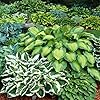
6 Pack of Mixed Heart-Shaped Hosta Bare Roots Plants, Rich Green Foliage, Low Maintenance for Your Home and Garden, Shipped Fresh & Daily from Our Coolers.
3. Juniper Bonsai: Classic Outdoor Beauty
Juniper Bonsai (Juniperus spp.) If you like that real tree look, try a juniper bonsai. This is a classic outdoor bonsai with soft green needles. Juniper bonsai require bright, direct sunlight, at least six to eight hours of full sunlight daily. It loves fresh air and sunshine. Juniper trees are fun to shape using wiring. You can train the branches to bend and grow in different directions.
Best for you if Beginner-Friendly Bonsai Species:
- You have a balcony, patio, or outdoor space
- Take pruning, with you like shaping trees with a strong style
- You want that traditional bonsai look
- Classic outdoor look, needs real sunlight
If you choose the best bonsai trees for beginners you choose, please make sure to use the right bonsai pot and soil, and give it the correct light and water. A starter kit can help you get the tree, tools, pot, and soil all in one box.
Getting an Exclusive Product on Amazon;
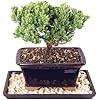
Brussel’s Bonsai Live Green Mound Juniper Bonsai Tree – Small, 3 Year, 4 to 6 Inches – Outdoor Bonsai Tree with Bonsai Pot and Bonsai Tray.
Juniper bonsai trees are a great way to symbolize good fortune during the Chinese New Year and beyond. As a hardy species, the bonsai tree can withstand harsh conditions, making it an ideal choice for those wishing to begin a new year on a positive note.
4. Chinese Elm: What Bonsai Tree Should a Beginner Choose First?
The Chinese elm (Ulmus parvifolia) is a popular, medium-sized, deciduous tree known for its attractive bark, which peels to reveal patches of gray, cream, orange, brown, and green. It’s native to Eastern Asia and widely cultivated for its hardiness and ability to adapt to various conditions. Chinese elms are also favored for bonsai due to their small leaves and fine branching patterns.
Best bonsai trees for beginners for you if:
- Indoor or outdoor
- Handles trimming well
- Hardy and fast-growing
The Chinese elm is happy indoors or outside, a tough and easy-to-start bonsai tree for beginners. It has tiny leaves and grows fast, which helps you practice pruning. Great for practicing trying Bonsai for the first time? This tiny tree won’t Let You Down.
Getting an Exclusive Product on Amazon;

Brussel’s Bonsai Live Chinese Elm Bonsai Tree, Outdoor – Small, 5 Years Old, 6 to 8 inches Tall – Includes Decorative Ceramic Bonsai Pot.
5. Japanese Maple (Acer palmatum): Which One Is the Best Bonsai Tree for Beginners Right for You?
Acer palmatum, commonly known as Japanese maple, palmate maple, or smooth Japanese maple, is a species of woody plant native to Korea, Japan, China, eastern Mongolia, and southeast Russia.
Its best outdoor tree has amazing red and orange leaves in the fall. It likes cooler weather and soft sunlight. Japanese maple is beautiful and calming, also it needs a little more care than ficus or jade.
Best bonsai trees for beginners for you if:
- Stunning fall color
- Best for cooler climates
- Outdoor bonsai only
Autumn is the best time to plant a Japanese Maple. Ideally, you should plant at least a month before the ground freezes, allowing for some root growth. As a wild tree, it grows 20-35 feet tall, occasionally more.
Getting an Exclusive Product on Amazon.
Red Japanese Maple (Outdoor Plant) – Live Plant 2-3 feet Tall – Deep Red Leaves.
| Plant or Animal Product Type | Tree |
| Indoor/Outdoor Usage | Outdoor |
| Brand | Japanese Maples and Evergreens |
| Material Feature | Organic |
| Color | Red |
| Special Feature | Deer Resistant |
| Expected Blooming Period | Spring |
| Item Weight | 2 Pounds |
| Sunlight Exposure | Partial Sun |
| Unit Count | 16 Ounce |
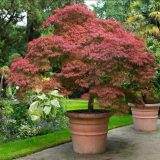
Now is the time to plant! Red Japanese Maple (Outdoor Plant) – Live Plant 2-3 feet Tall – Deep Red Leaves. Cooler temperatures and more rainfall provide a smooth transition for the plants.
As long as your soil is not frozen solid 2 inches below ground level, the roots will still take perfectly and continue to grow throughout the winter. This gives you a head start on the spring and summer of production.
6. Cotoneaster Bonsai: Start Simple: Best Bonsai Trees for Beginners Explained.
A fun bonsai that gives you flowers and berries! Cotoneaster is small, strong, and grows well outside. The Cotoneaster bonsai plant is a good choice for attractive bonsai trees, especially in small sizes like Shohin, Kifu, or Chuhin, and it is also very suggests for beginner miniature lovers. It also has tiny leaves that look great in a bonsai shape.
Beginner easy bonsai tree for you if:
- Hardy outdoor tree
- Cute flowers and red berries
- Small leaves, easy to shape
The cotoneaster is an evergreen shrub that tends to grow upright with long branches rather than as a bush. Its bright orange berries grow in clusters so thick that the branches cannot be seen. Cotoneaster is poisonous in large amounts and may cause trouble breathing, weakness, and seizures.
Outdoor Plant By Amazon: 30 Wall Cotoneaster Seeds for Planting – Fruit-Bearing Ornamental Vine – Cotoneaster Horizontalis.
| Plant or Animal Product Type | Fruit |
| Brand | CZ Grain |
| Color | red green |
| Expected Blooming Period | Summer, Fall |
| Sunlight Exposure | Full Sun |
| Unit Count | 30.0 Count |
| Expected Planting Period | Summer |
| Soil Type | Sandy Soil |
| Moisture Needs | Moderate Watering |

About Outdoor item: 30 Wall Cotoneaster Seeds for Planting – Fruit-Bearing Ornamental Vine – Cotoneaster Horizontalis.
About this item: 30 Wall Cotoneaster Seeds for Planting Outdoor- Fruit-Bearing Ornamental Vine – Cotoneaster Horizontalis.
- ORNAMENTAL FAVORITE: Discover the exquisite beauty of Cotoneaster horizontalis, a short shrub also known as Rock Cotoneaster, Wall Cotoneaster or Rockspray Cotoneaster. It’s an ornamental gem, widely grown in gardens and public parks for its stunning, berry-like pomes, which turn a vibrant red and are a source of nutrition for birds.
- EASY TO GROW: Cold stratification is benefical for this species. Sew outdoors after the threat of frost has passed or start indoors. Plant 1/2 inch deep, and keep the seedbed free of weeds and grasses. Water as needed.
- GREAT FOR LANDSCAPING: If you’re looking for a substantial ground cover or an eye-catching feature plant, Cotoneaster horizontalis will not disappoint.
7. Larch Bonsai Plant: Are the Best Bonsai Trees for Beginners First-Timers?
Larch (Larix spp.) bonsai is a special outdoor seasonal plant. It’s a conifer that loses its needles in winter! It’s very strong and loves the cold. Larch bonsai are known for their adaptability to various bonsai styles and their resilience, making them suitable for both beginners and experienced lovers.
The best beginner easy bonsai tree for you is:
- Cold-hardy
- Seasonal needle change
- Grows outdoors only
Key Features of Larch Bonsai: How to Choose the Right Bonsai Tree for Your First Try?
Larch bonsai are a popular choice due to their unique characteristics and seasonal changes. A great larch bonsai for outdoor seasons and offers lots of character year-round.
- Deciduous Conifer: Unlike most conifers, larches shed their needles in the fall, showcasing their branch structure and bark.
- Seasonal Interest: The needles emerge in spring with a vibrant green, darken in summer, and turn golden yellow in autumn before dropping.
- Attractive Bark: The bark of mature larches develops attractive fissures and textures, adding to their visual appeal.
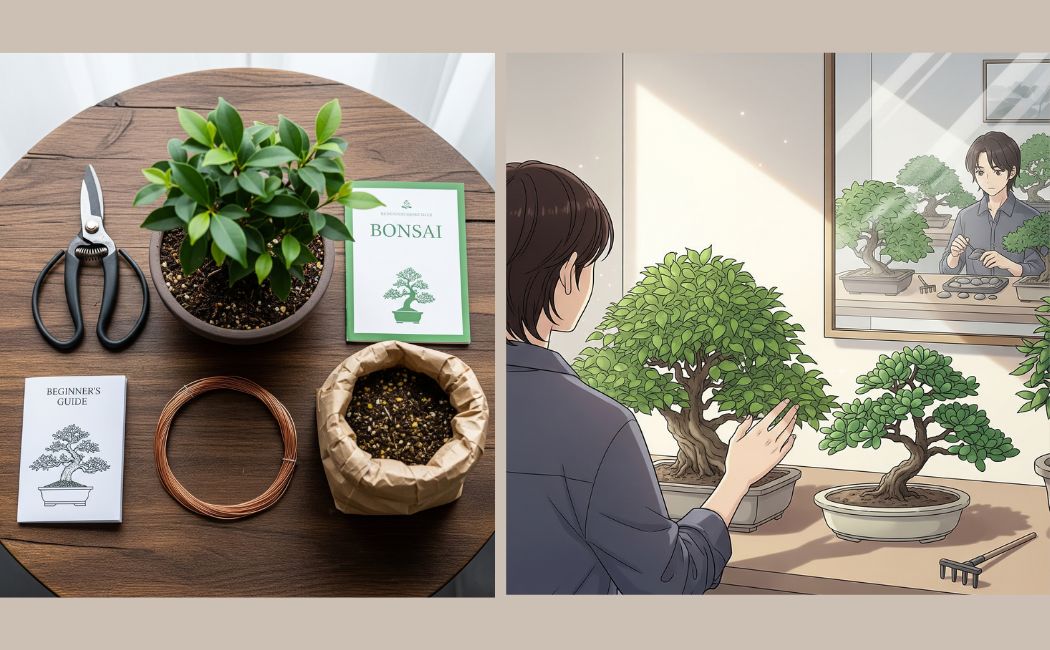
Larch Bonsai Plant Versatile Styling: The Best Bonsai Tree For Beginners Practicing Plant.
The beginner easy bonsai tree larches can be styled in various forms, including informal upright, slanting, and cascading.
- Hardiness: They are generally hardy and can tolerate a range of temperatures, making them suitable for outdoor bonsai cultivation.
- Pruning and Wiring: Larches respond well to pruning and wiring, allowing for shaping and refinement.
- Watering and Soil: They prefer well-draining soil and regular watering, but avoid overwatering or letting the soil dry out completely.
- Sunlight: Larches generally prefer full sun but can also tolerate some shade.
Outdoor Plant by Amazon: 30 Japanese Larch Bonsai Tree Seeds for Planting.

Popular for Larch bonsai plant exotic-looking tree has colorful evergreen leafs, and the wood can achieve a prized “Shari” look.
Popular Larch Species for Bonsai: Which Bonsai Tree Fits Your Space and Skill? Beginner Picks Inside?
- Japanese Larch (Larix kaempferi): Known for its graceful, slender trunk and good cold tolerance.
- European Larch (Larix decidua): Features a more upright, pyramidal shape and is very cold-hardy.
- Chinese Golden Larch: It’s Larix gmelinii var. principis-rupprechtii has an open, irregular growth habit and cascading branches.
Why Considerations for Larch Bonsai is the Best For Beginners?
- Soil: Use a well-draining soil mix that includes gritty materials like gravel and pumice, with some organic matter.
- Watering: Maintain consistent moisture, but avoid waterlogging.
- Winter Protection: While hardy, protect bonsai larches from extreme frost once potted in a bonsai container.
- Repotting: Repotting is generally done in early spring before new growth emerges.
The best beginner bonsai ever is deciduous conifers, meaning they lose their needles in the fall, revealing attractive branch structure and bark.
8. Pine Bonsai: New to Bonsai? Are the Best Trees for First-Timers?
Pine trees (Pinus spp.) are beginner easy bonsai tree that are tough and live a long time. Pines Bonsai are especially popular, and many people even regard them as the most typical Bonsai trees. They are a favorite in Japanese gardens and are great for more classic bonsai looks. They need more light and care, but are strong and rewarding.
- Classic, strong bonsai
- Long life
- Needs good sun and airflow.
Place the pine Bonsai outside in full sun. This helps the first and second flush of growth develop and helps decrease the needle size.
Amazon Product: Japanese Black Pine – Bonsai Starter – Pinus thunbergii – 3-Year Tree.
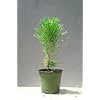
Japanese Maples and Evergreens are Outdoor plants. Expected Blooming Period: Winter, Summer, Spring. USDA Hardiness Zone 5. color black.
3-Year tree – comes in a container with original soil and is very Hardy in Zones 5-9.
Propagating Pine Bonsai: Beginner Easy Bonsai Tree.
Take a cutting with disinfected pruning shears, about 2 to 3 inches long, from a regular pine tree of your choice. Cut it at a 45-degree angle. Plant the cutting about 1 inch deep in a pot prepared with bonsai potting soil and water. Put the cutting in a sunny location.
What are the disadvantages of a Pine bonsai tree?
Keeping a Pine Bonsai Tree inside the house may not be favorable for your pets, as they are toxic to both cats and dogs. Ingesting Bonsai can cause respiratory problems in pets. Mite infestation and other insects can easily harm Bonsai, which beginner easy bonsai tree is another reason why it is not so beneficial to keep them at home.
9. Schefflera Dwarf Plant: Beginner Easy Bonsai Tree
Schefflera bonsai, also known as Hawaiian Umbrella bonsai, is a popular choice for indoor cultivation due to its hardiness and unique appearance. These bonsai are known for their distinctive, hand-like leaves and their potential for developing interesting aerial roots in banyan-style designs. This tropical tree grows fast and doesn’t need much care. Schefflera is perfect for beginners who want an indoor bonsai. It’s forgiving and does well in most homes.
- Grows indoors
- Needs little care
- Fun for shaping and root training
Proper care involves providing bright, indirect light, regular watering, allowing the top inch of soil to dry out, and occasional fertilization. Pruning and wiring techniques can be used to shape the tree and encourage smaller leaves and branching.

Brussel’s Bonsai Live Hawaiian Umbrella Bonsai Tree – Small, 3 Year, 4 to 7 Inches Tall – Indoor Bonsai Tree with Bonsai Pot and Bonsai Tray.
Key Aspects of Schefflera Bonsai Care: Best Beginner Bonsai Ever.
- Light: Schefflera bonsai thrives in bright, indirect sunlight. Avoid direct sunlight, which can scorch the leaves.
- Watering: Water when the top inch of soil feels dry to the touch. Ensure proper drainage to prevent overwatering and root rot.
- Fertilizing: Fertilize regularly, especially during the growing season (spring and summer), using a balanced liquid fertilizer.
- Pruning: Regular pruning is essential for maintaining the desired shape and size of the bonsai. Remove dead or damaged branches and trim back unruly growth.
- Styling: Schefflera bonsai can be styled in various ways, including banyan style, single trunk, or forest style. Aerial roots can be encouraged through humidity and proper techniques.
- Humidity: Schefflera bonsai appreciates moderate humidity. A humidity tray can be helpful, especially in dry indoor environments.
- Temperature: Maintain a temperature range of 65°F to 72°F (18°C to 22°C). Protect from frost and freezing temperatures.
- Pests and Diseases: Aphids can be a common pest, especially on new growth. Regularly inspect your bonsai and address any pest issues promptly.
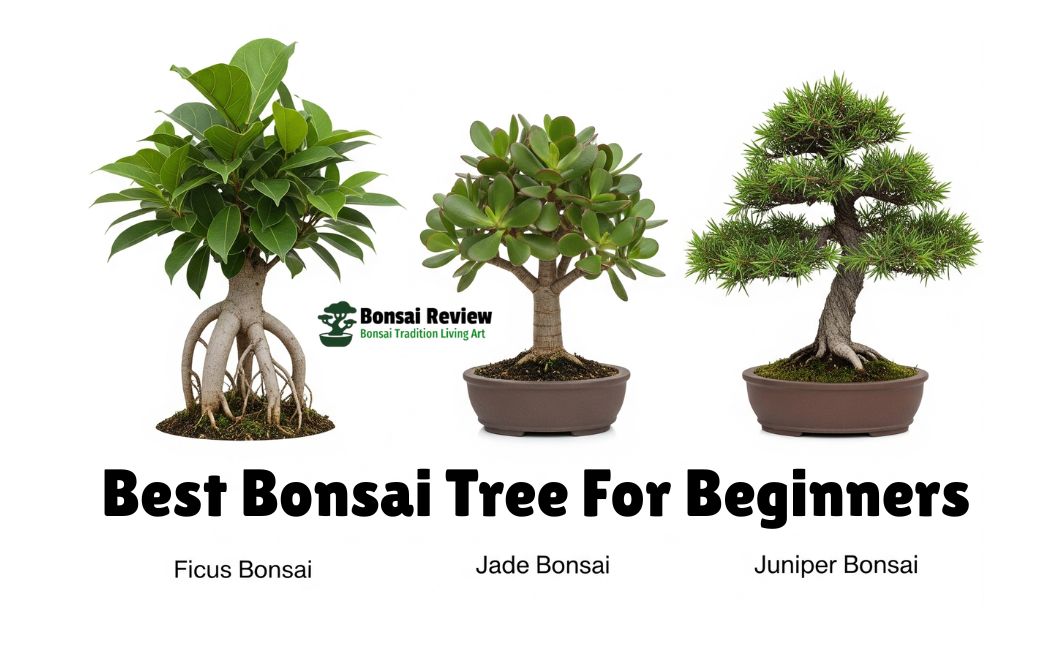
Indoor or Outdoor: What’s the Easiest Bonsai Tree to Grow at Home?
Not all bonsai trees like the same home. Some need fresh air and sun, while others grow well inside by a window. Here’s a simple best beginner bonsai ever to help you choose the right one for your space and daily routine:
| Bonsai Tree | Grows Best | Needs Direct Sun? | Watering Needs | Best Bonsai Tree For Beginners Lovers, If |
| Ficus Bonsai | Indoors | No | Medium | You live in an apartment or get soft light indoors |
| Jade plant | Indoors | Yes (bright window) | Low | You often forget to water or travel a lot |
| Juniper | Outdoors | Yes | Medium | You have a balcony or garden with sunlight |
| Chinese Elm | Indoors or Outdoors | Some Sun | Medium | You want a tree that adjusts to seasons |
| Schefflera | Indoors | No | Low to Medium | You need a low-light bonsai for home or office |
| Cotoneaster | Outdoors | Yes | Medium | You want flowers and berries in your bonsai |
| Japanese Maple | Outdoors | Yes (soft morning sun) | Medium | You enjoy colorful leaves and cooler climates |
Quick Tip: Looking for the Best Bonsai Tree for Beginners? Start Here Beginner Easy Bonsai Trees.
If you’re unsure, start with an indoor bonsai like Ficus or Jade, especially if you don’t get full sun. If you have a sunny spot outside, a juniper or maple will thrive and look stunning.
What Makes a Bonsai Tree Easy for Beginners?
Not all bonsai trees are beginner-friendly. Some need a lot of care, trimming, and the right kind of weather. But when you’re just starting, it’s better to choose a tree that’s easy to grow, strong, and simple to care for. That way, you won’t get stressed or feel like giving up.
A good beginner bonsai has strong roots, and small leaves, and can live in a shallow bonsai pot without trouble. It should grow well in regular home light or outdoor sun, depending on where you plan to keep it.
The best beginner easy bonsai tree can live indoors and is forgiving if you miss a watering or two. Jade holds water in its leaves, so it needs even less attention. Juniper, while outdoors, loves the sun and fresh air, but still forgives small mistakes with pruning or wiring.
Also, beginner easy bonsai trees don’t grow too fast or too slow. They grow just enough to let you practice shaping, trimming, and watching them change. Look for bonsai trees for beginners tiny plants that are hardy, which means they don’t get sick or weak easily. These small things make a big difference when you’re just learning.
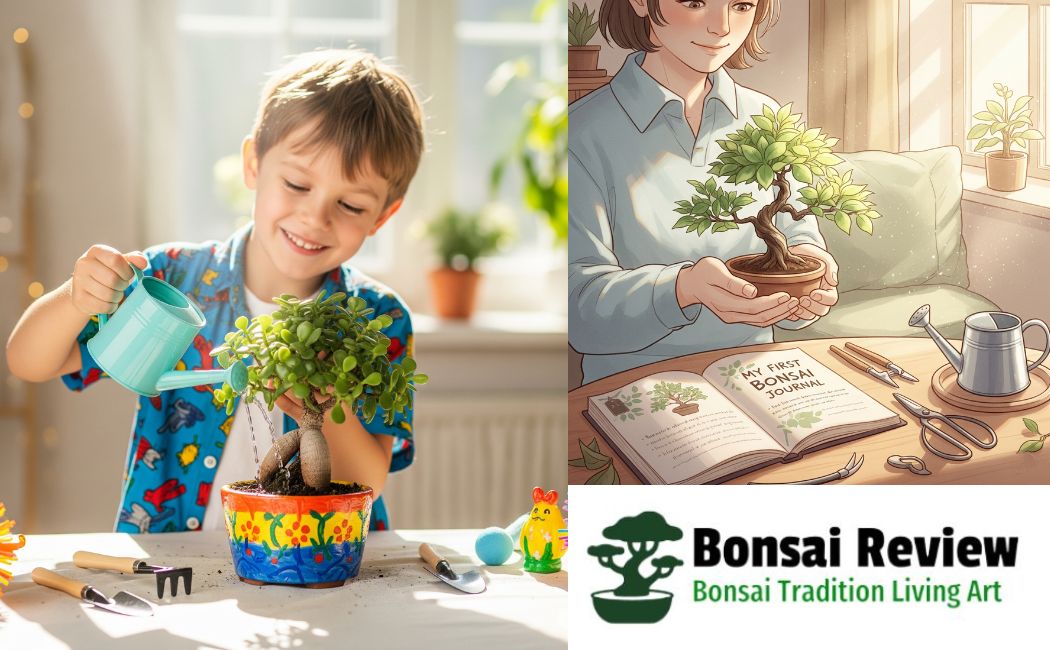
How to Care for Your First Bonsai Tree? Which Bonsai Fits Your Life?
The best beginner bonsai ever for caring for a bonsai plant is like looking after a tiny, quiet friend. A beginner’s easy bonsai tree takes time, care, and small steps, but it’s not hard when you know what to do. Here’s what you need to start:
1. Use the Right Bonsai Pot: Your bonsai needs a shallow pot with holes at the bottom. This helps water drain out so the roots don’t rot. Always use a bonsai pot, not a regular plant pot.
2. Pick Good Soil: Bonsai trees need special soil that drains well. You can buy a bonsai soil mix or use a kit that comes with bonsai trees for beginners. Never use garden soil; it holds too much water.
3. Water Gently: Touch the soil. If it feels dry, it’s time to water. Don’t let it get bone dry, but don’t keep it soggy either. Use a small watering can or a soft spray. Jade needs less water than ficus or juniper.
4. Give It the Right Light: The best bonsai tree for beginners, friendly Indoor bonsai like ficus and jade, need bright, soft light like near a window. Outdoor bonsai like juniper need direct sun. Always match the tree to your space.
5. Start With Simple Pruning: When you see a branch growing too long or in the wrong spot, clip it with bonsai scissors. This helps keep the shape small. Pruning also makes the tree grow stronger.
For example, Tough and easygoing, the Chinese elm is happy indoors or outside. It has tiny leaves and grows fast, which helps you practice pruning. Great for learning bonsai trees for beginners.
6. Try Wiring (Only If You Want): The best bonsai tree for beginners to practice Wiring is used to bend and shape branches. You don’t have to do this right away. Start with pruning. When you feel ready, learn to wire safely never too tight.
7. Be Patient: Bonsai is slow on purpose. It teaches patience, peace, and care. You won’t see big changes in a week. But over time, your tree will grow with you and become something beautiful.
For example of the bonsai trees for beginners, the juniper bonsai tree that most people picture. Junipers love the outdoors and fresh air. It’s flexible, easy to wire, and fun to style. But they don’t like to live inside, so give them a spot with the sun.
Good to Know: If you’re not sure where to start, a bonsai starter kit gives you the pot, soil, tools, and a beginner-friendly tree all in one box.
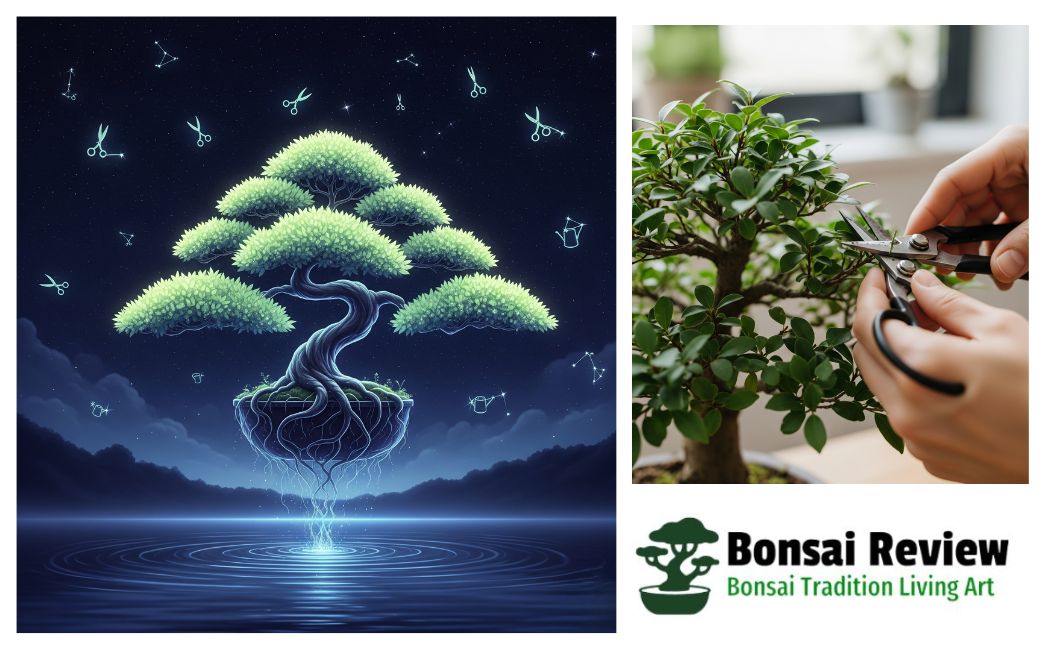
Where Can You Get a Good Beginner Bonsai Tree?
Buying your first bonsai tree can feel tricky. But there are many places to find one that fits your needs. Local garden centers often have bonsai trees and can give advice. It’s great to see the tree in person before buying.
You can also buy bonsai trees online from trusted sellers like Bonsai Boy, Eastern Leaf, Brussels Bonsai, or Bonsai of Brooklyn. They offer beginner-friendly trees, and many send starter kits with soil, pots, and care guides. When buying, you might hear these words:
- Pre-bonsai: A young tree that still needs shaping and training.
- Nursery stock: Beginner easy bonsai trees that are partly trained and ready for beginners.
- Starter kits: Everything you need to start in one box, including a bonsai tree, pot, soil, and tools.
Avoid rare or very old bonsai trees at first; beginner easy bonsai trees need special care and skill. Starting with a bonsai starter kit is a smart choice. It helps you learn step-by-step and gives you the right tools and soil.
Still Not Sure? Start With a Bonsai Starter Kit
If picking the perfect bonsai tree feels overwhelming, a bonsai starter kit is a great way to begin. These kits include everything you need: a young bonsai tree, a shallow bonsai pot, special soil, and simple tools for pruning and care.
Starter kits take away the guesswork. They guide you step-by-step, making it easier to learn how to water, shape, and keep your bonsai healthy. Plus, they usually come with easy instructions that explain how to use wiring safely when you’re ready.
If you want to grow a ficus, jade, or juniper bonsai, a starter kit gives you a simple, all-in-one package to build your skills and confidence.
So, if you’re nervous or don’t know where to start, a bonsai starter kit might be your best friend on this peaceful and rewarding journey.
Bonsai Fertilizer – Gentle Slow Release Plant Food Pellets – Ideal for All Indoor and Outdoor Bonsai Tree Plants in Pots (5 oz).

Conveniently packed and ready to use, plant food formulated for all types of indoor and outdoor live bonzai trees like Juniper, Ficus, Schefflera, Ginseng, Jade, Bamboo, Money, Fukien Tea, Satsuke Azalea, and other dwarf tree varieties.
Bonsai care made easy: No need to heavily mix our granular fertilizer into your potting soil. Just carefully place pellets around the base of your tree and watch it thrive with every watering! Great for pots with gravel, moss, pebbles, pumice, lava rocks, and other organic soil mixes.
Conclusion: Which Is the Best Bonsai Tree for Beginners? Start Smart, Grow Easy!
Choosing the best bonsai tree for beginners doesn’t have to be hard. You’ve now seen the top beginner-friendly trees like ficus, jade, Chinese Elm, juniper, and more. Each one offers something special; some grow indoors, some like the sun, but all are strong and great for learning.
Start simple and grow with joy, bonsai lovers. Choose a dwarf plant. Pick one tree that fits your space and lifestyle. If you’re still unsure, a bonsai starter kit makes it even easier. It gives you everything you need and removes the guesswork.
Bonsai isn’t about being perfect. It’s about learning, slowing down, and enjoying each step. the best beginner bonsai ever with the right tree, a little care, and your patience, you’ll soon grow more than just a plant; you’ll grow a peaceful habit that lasts a lifetime.
More informative article: Simple Guide on How to Grow a Bonsai Tree for Beginners.
FAQs: The Best Bonsai Tree For Beginners Questions, Answered Simply.
1. What is the easiest bonsai tree to care for?
The ficus bonsai is one of the easiest. It grows indoors, handles missed waterings, and bounces back fast. If you’re busy and forget to water, a jade bonsai is perfect it stays healthy even if you water only once a week. But if you want to practice shaping with wires, try a juniper bonsai. The best beginner bonsai ever bends well and holds its form nicely
2. Is the Chinese Elm Plant Medicinal?
A species of elm native to China, Korea, and Japan has shown that its leaves and stems have anti-inflammatory and antioxidant effects. Parvifolia bark, which contains phenolic compounds and steroidal glucosides, is used for the treatment of eczema and edema.
3. Can I keep a bonsai tree inside my house?
Yes! Beginner easy bonsai trees like Ficus, Jade, and Schefflera are great for indoor spaces with bright light.
4. How often do I need to water a bonsai?
A beginner easy bonsai tree depends on the tree and where it lives. Touch the soil if it feels dry, and water it. Jade needs less water than others.
5. What tools do I need to start?
Just a few: pruning scissors, a small watering can, and maybe some soft wire later. Starter kits include these.
6. Can I grow a bonsai from seed?
Yes, you can, but it takes many years. The best bonsai tree for beginner lovers. It’s better to start with a young tree or a starter kit.
7. Are bonsai trees high-maintenance?
Not if you pick the right one. Beginner trees like ficus and jade are low-maintenance and very forgiving.
8. What happens if I forget to water my bonsai?
Some trees, like jade, are okay if you miss a day or two. But try to check it every day to be safe.
9. How long does a bonsai tree live?
With good care, bonsai trees can live for decades, even 100 years! Many live much longer than regular houseplants.